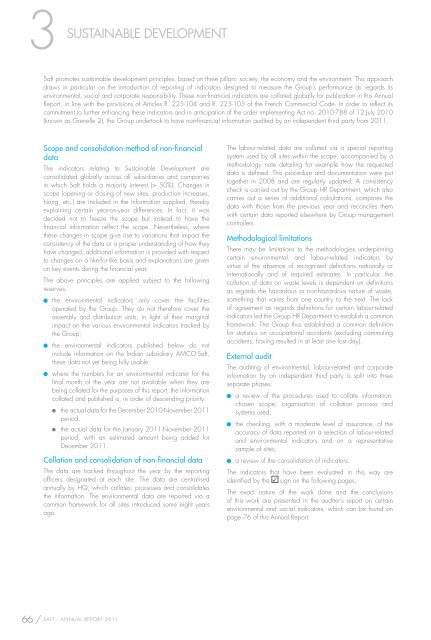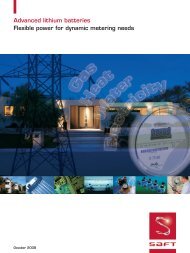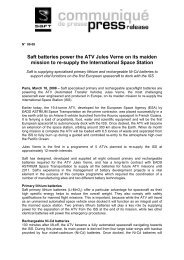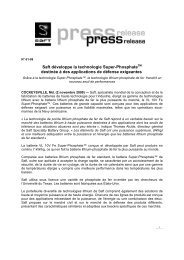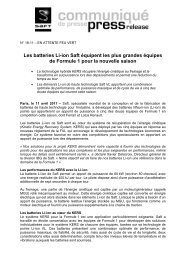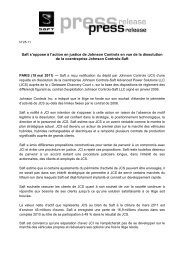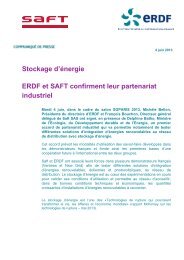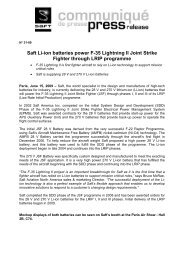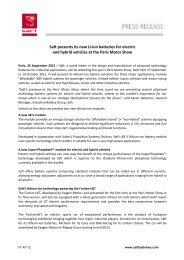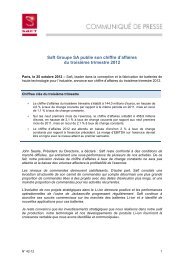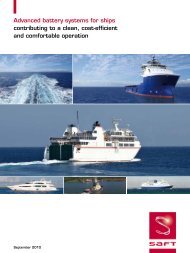ANNUAL REPORT 2011 REGISTRATION DOCUMENT - Saft
ANNUAL REPORT 2011 REGISTRATION DOCUMENT - Saft
ANNUAL REPORT 2011 REGISTRATION DOCUMENT - Saft
You also want an ePaper? Increase the reach of your titles
YUMPU automatically turns print PDFs into web optimized ePapers that Google loves.
3<br />
SUSTAINABLE DEVELOPMENT<br />
<strong>Saft</strong> promotes sustainable development principles, based on three pillars: society, the economy and the environment. This approach<br />
draws in particular on the introduction of reporting of indicators designed to measure the Group’s performance as regards its<br />
environmental, social and corporate responsibility. These non-fi nancial indicators are collated globally for publication in this Annual<br />
Report, in line with the provisions of Articles R. 225-104 and R. 225-105 of the French Commercial Code. In order to refl ect its<br />
commitment to further enhancing these indicators and in anticipation of the order implementing Act no. 2010-788 of 12 July 2010<br />
(known as Grenelle 2), the Group undertook to have non-fi nancial information audited by an independent third party from <strong>2011</strong>.<br />
Scope and consolidation method of non-financial<br />
data<br />
The indicators relating to Sustainable Development are<br />
consolidated globally across all subsidiaries and companies<br />
in which <strong>Saft</strong> holds a majority interest (> 50%). Changes in<br />
scope (opening or closing of new sites, production increases,<br />
hiring, etc.) are included in the information supplied, thereby<br />
explaining certain year-on-year differences. In fact, it was<br />
decided not to freeze the scope but instead to have the<br />
fi nancial information refl ect the scope. Nevertheless, where<br />
these changes in scope give rise to variations that impact the<br />
consistency of the data or a proper understanding of how they<br />
have changed, additional information is provided with respect<br />
to changes on a like-for-like basis and explanations are given<br />
on key events during the fi nancial year.<br />
The above principles are applied subject to the following<br />
reserves:<br />
� the environmental indicators only cover the facilities<br />
operated by the Group. They do not therefore cover the<br />
assembly and distribution units, in light of their marginal<br />
impact on the various environmental indicators tracked by<br />
the Group;<br />
� the environmental indicators published below do not<br />
include information on the Indian subsidiary AMCO-<strong>Saft</strong>,<br />
these data not yet being fully usable;<br />
� where the numbers for an environmental indicator for the<br />
fi nal month of the year are not available when they are<br />
being collated for the purposes of this report, the information<br />
collated and published is, in order of descending priority:<br />
� the actual data for the December 2010-November <strong>2011</strong><br />
period,<br />
� the actual data for the January <strong>2011</strong>-November <strong>2011</strong><br />
period, with an estimated amount being added for<br />
December <strong>2011</strong>.<br />
Collation and consolidation of non-financial data<br />
The data are tracked throughout the year by the reporting<br />
offi cers designated at each site. The data are centralised<br />
annually by HQ, which collates, processes and consolidates<br />
the information. The environmental data are reported via a<br />
common framework for all sites introduced some eight years<br />
ago.<br />
66 / SAFT - <strong>ANNUAL</strong> <strong>REPORT</strong> <strong>2011</strong><br />
The labour-related data are collated via a special reporting<br />
system used by all sites within the scope, accompanied by a<br />
methodology note detailing for example how the requested<br />
data is defi ned. This procedure and documentation were put<br />
together in 2008 and are regularly updated. A consistency<br />
check is carried out by the Group HR Department, which also<br />
carries out a series of additional calculations, compares the<br />
data with those from the previous year and reconciles them<br />
with certain data reported elsewhere by Group management<br />
controllers.<br />
Methodological limitations<br />
There may be limitations to the methodologies underpinning<br />
certain environmental and labour-related indicators by<br />
virtue of the absence of recognised defi nitions nationally or<br />
internationally and of required estimates. In particular, the<br />
collation of data on waste levels is dependent on defi nitions<br />
as regards the hazardous or non-hazardous nature of waste,<br />
something that varies from one country to the next. The lack<br />
of agreement as regards defi nitions for certain labour-related<br />
indicators led the Group HR Department to establish a common<br />
framework. The Group thus established a common defi nition<br />
for statistics on occupational accidents (excluding commuting<br />
accidents, having resulted in at least one lost day).<br />
External audit<br />
The auditing of environmental, labour-related and corporate<br />
information by an independent third party is split into three<br />
separate phases:<br />
� a review of the procedures used to collate information:<br />
chosen scope, organisation of collation process and<br />
systems used;<br />
� the checking, with a moderate level of assurance, of the<br />
accuracy of data reported on a selection of labour-related<br />
and environmental indicators and on a representative<br />
sample of sites;<br />
� a review of the consolidation of indicators.<br />
The indicators that have been evaluated in this way are<br />
identifi ed by the P sign on the following pages.<br />
The exact nature of the work done and the conclusions<br />
of this work are presented in the auditor’s report on certain<br />
environmental and social indicators, which can be found on<br />
page 76 of this Annual Report.


